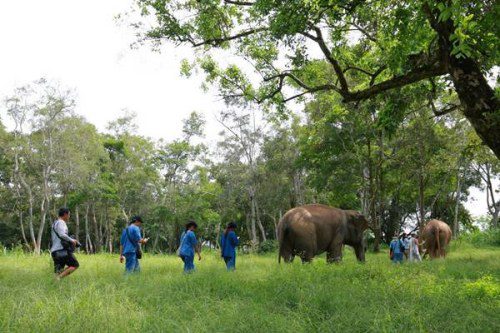 Immerse yourself in the heart of Thailand’s grand wildlife and journey into the oneness of the universe.
Immerse yourself in the heart of Thailand’s grand wildlife and journey into the oneness of the universe.
The elephant is an integral part of Thai culture and history. Revered for their awe-inspiring presence, elephants symbolize the Thai royalty dynasty due to their longevity and historical significance, including their role in Thailand’s fight for independence. These majestic creatures have helped forge Thailand into the strong nation it is today.
In the past, elephants were instrumental in warfare, most notably in the legendary single combat between King Naresuan and the Crown Prince of Burma, Myingyi Swa. This battle stands as a vital part of Thai history, with King Naresuan’s victory freeing the Thais from Burmese subjugation.
During the reign of King Rama IX, elephants were cherished as royal animals. They also represented the nation in international relations and diplomacy, often participating in overseas missions and ceremonies.
However, in recent years, Thailand has faced challenges with domesticated elephants wandering into urban areas. Often, their mahouts (handlers) have them venture into these regions to sell food and earn a living, leading to unfortunate accidents and mistreatment.
Additionally, the tourism industry has negatively impacted elephants. Many are uprooted from their natural habitats, subjected to inhumane training, and exploited for entertainment such as circuses and tourist rides, resulting in injuries and harsh living conditions.
To address these issues, various foundations have initiated elephant conservation efforts aimed at providing a more natural environment. These projects promote responsible tourism, allowing elephants to roam freely and interact with visitors without unnatural coercion. An example of such a project is the “Anantara Golden Triangle Elephant Camp & Resort,” run by the Golden Triangle Asian Elephant Foundation.
The camp covers over 40 acres of forest and provides a home for more than 20 elephants, along with their mahouts and families. It aims to mitigate urban elephant issues while ensuring the elephants’ well-being. During a visit, visitors get to observe the elephants in their natural habitat, fostering a deeper connection and appreciation for these incredible creatures.
 As you travel further north, immerse yourself in the artistic legacy of Chiang Rai at Wat Rong Khun. To miss this destination is to miss a true taste of Chiang Rai’s essence.
As you travel further north, immerse yourself in the artistic legacy of Chiang Rai at Wat Rong Khun. To miss this destination is to miss a true taste of Chiang Rai’s essence.
Here, the ever-evolving contemporary art scene coexists with teachings of Dhamma, imbuing life philosophies through endless artistry.
Your journey to the ordination hall begins with a symbolic bridge from hell to heaven, leading you to the Buddha Sculpture. The path, marked with sculptures, embodies the journey from the inferno, a reminder of life’s hardships, to a state of peace and bliss, represented by the magnificent Buddha in the ordination hall.
The province of Chiang Rai is home to legendary artists such as Thawal Dachanee and Chalermchai Kositpipat. Dachanee’s work at the Black House Museum explores human consciousness, while Kositpipat’s art at Wat Rong Khun represents the purity and cleanliness of the soul.
Kositpipat’s art is rooted in his study of Buddhism, which transformed his life and led him to true happiness. He aims to educate people about life’s true essence through his art, making Wat Rong Khun an internationally renowned attraction.
The core principles that drive Kositpipat’s art at Wat Rong Khun are Nation, Religion, and King. His compassion for the country, the profound impact of Dhamma on his life, and his respect for King Rama 9 serve as pillars for his creations.
The adaptability and resilience of the Thai people have allowed them to maintain their independence and unique culture throughout history, particularly their deep connection to Buddhism. These aspects form the foundations of the four landmark destinations, inspiring travelers to journey through the country and experience the warm hospitality and rich culture of Thailand.
Written By: Prakaidown Baengsuntia

